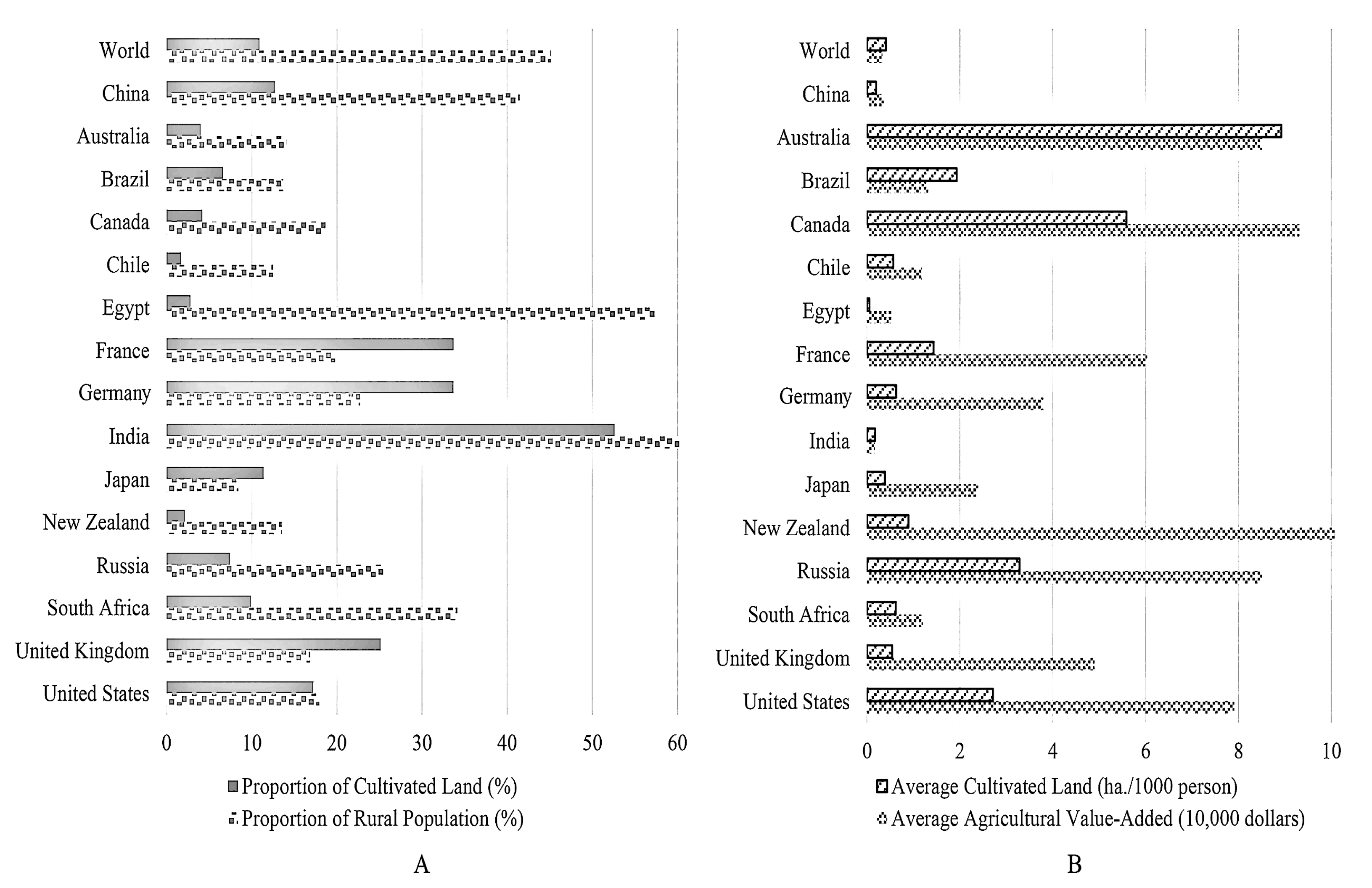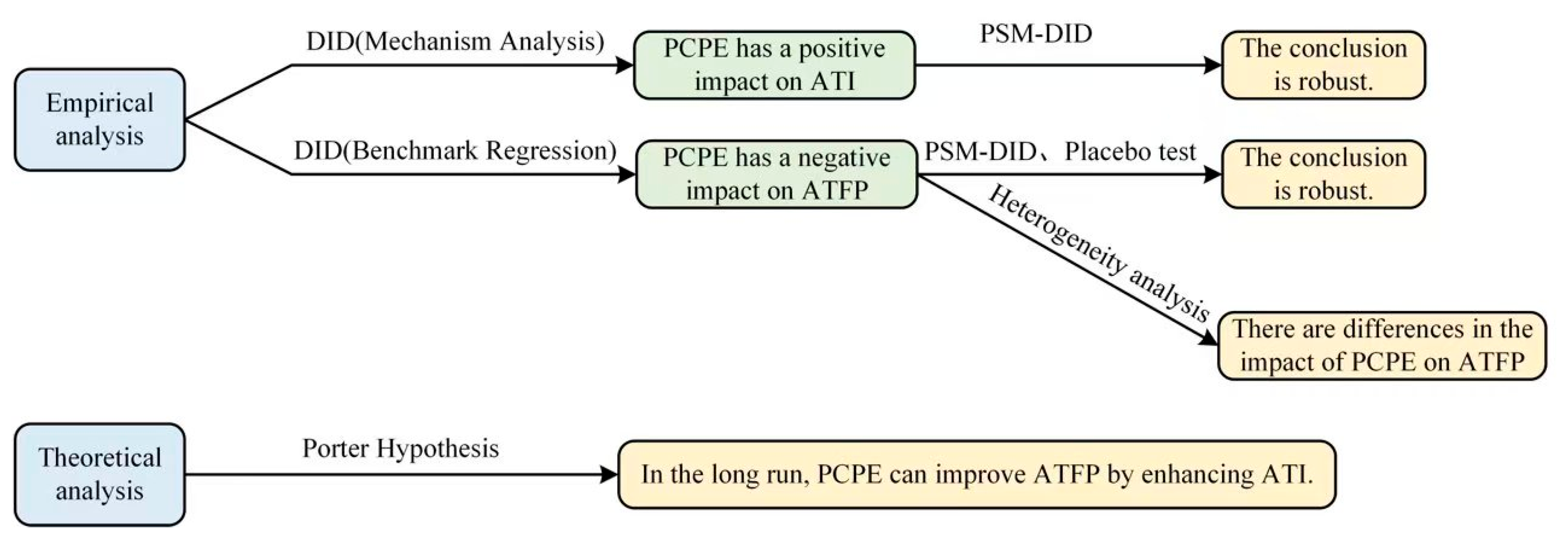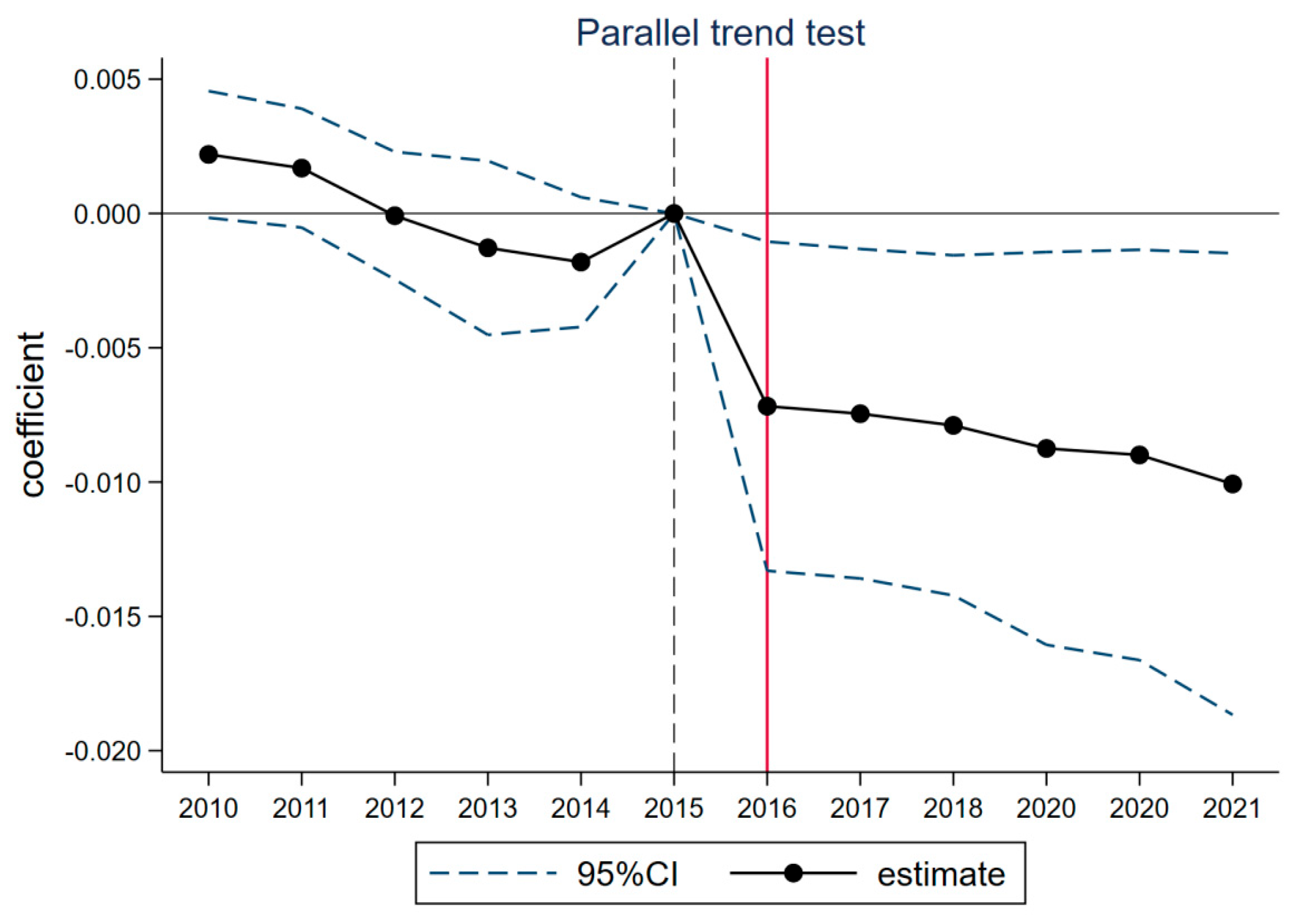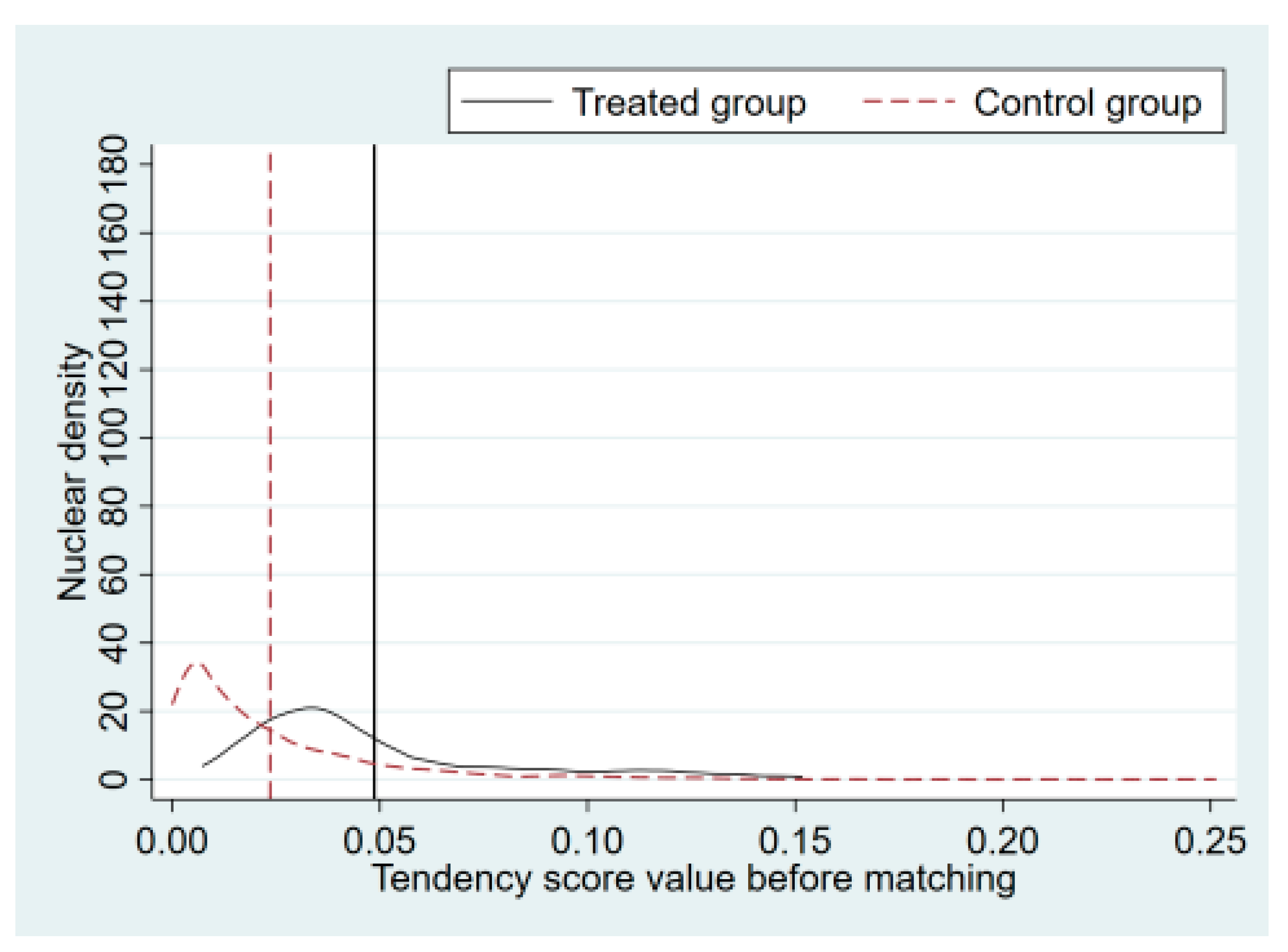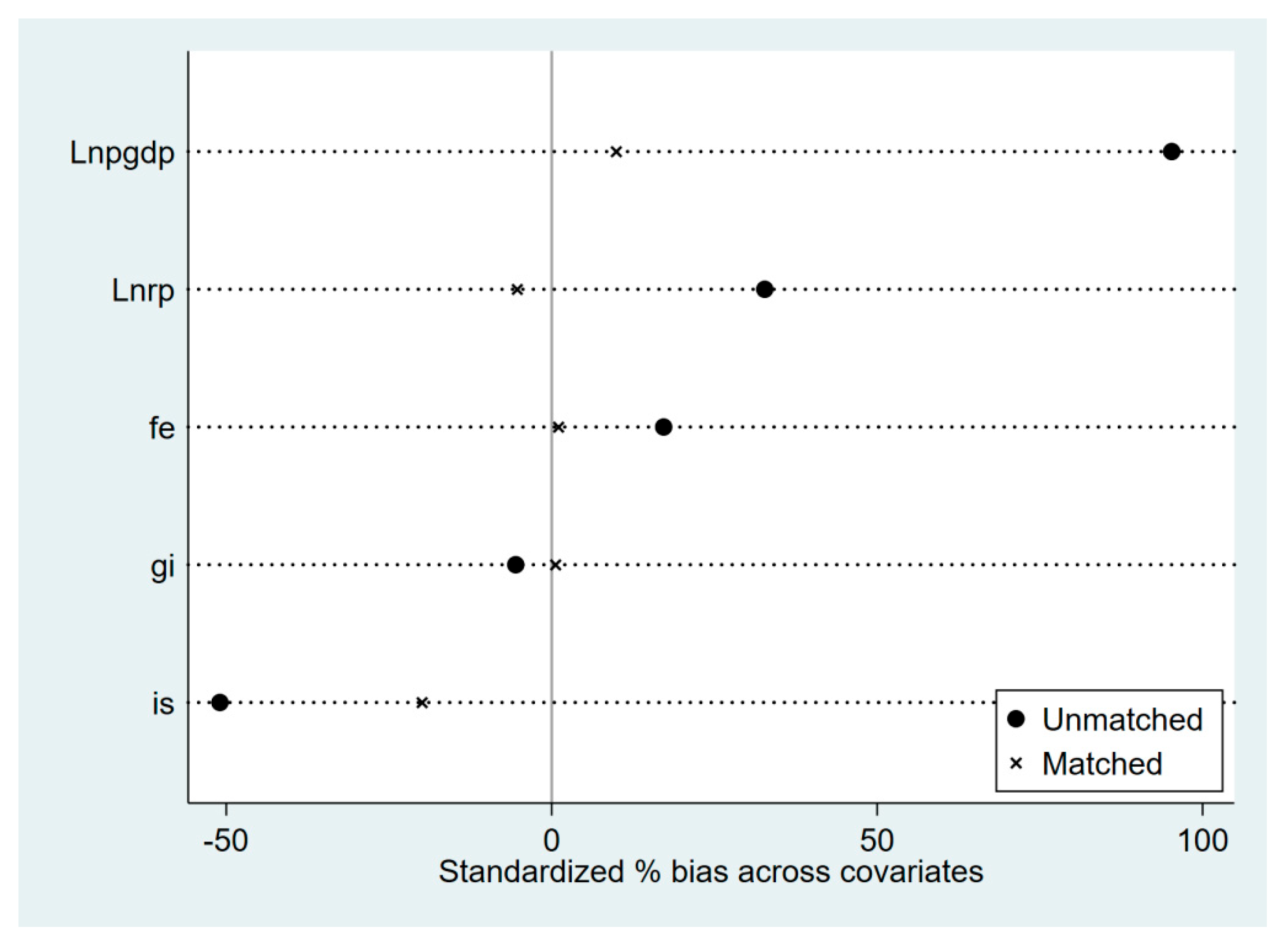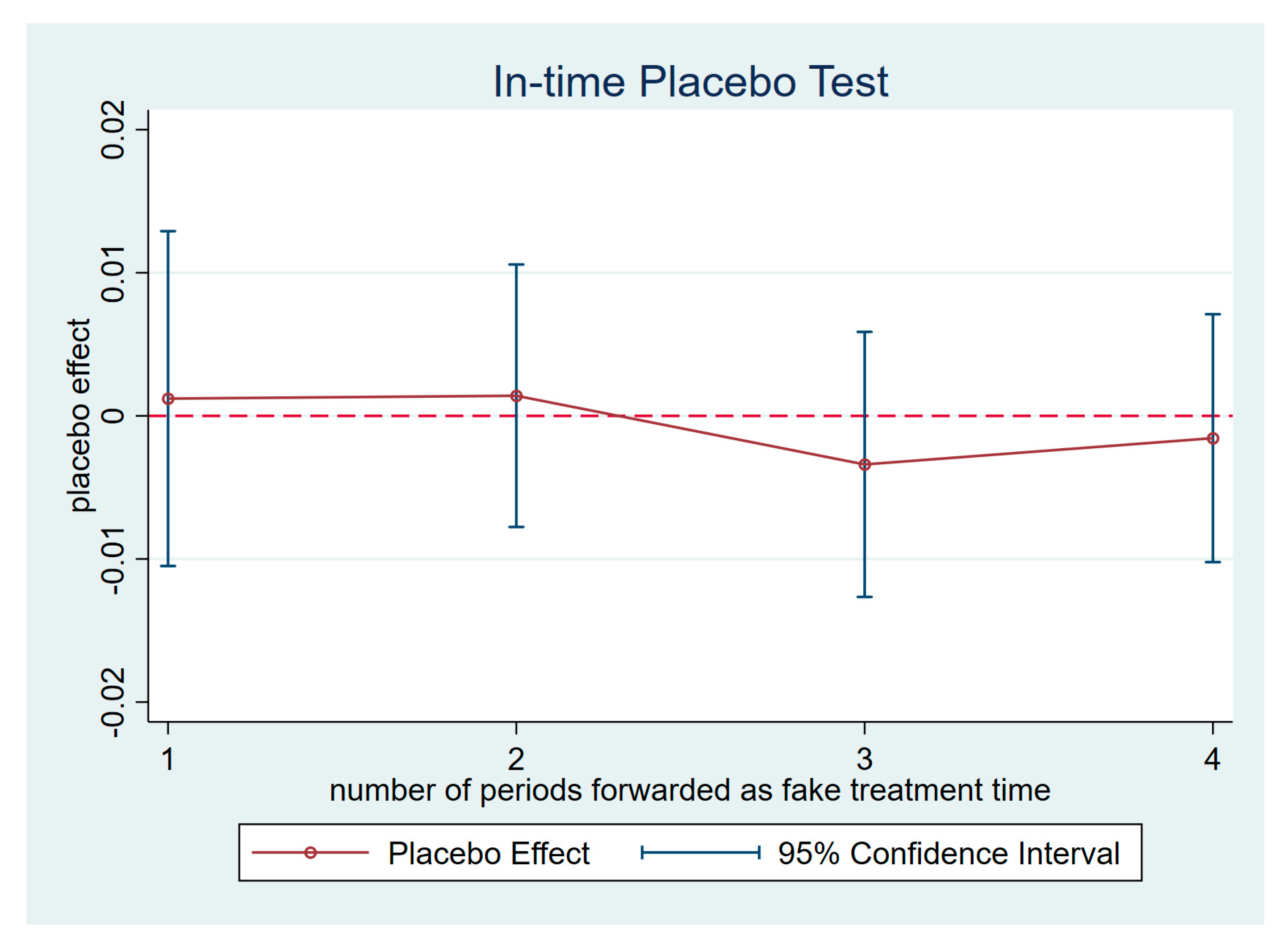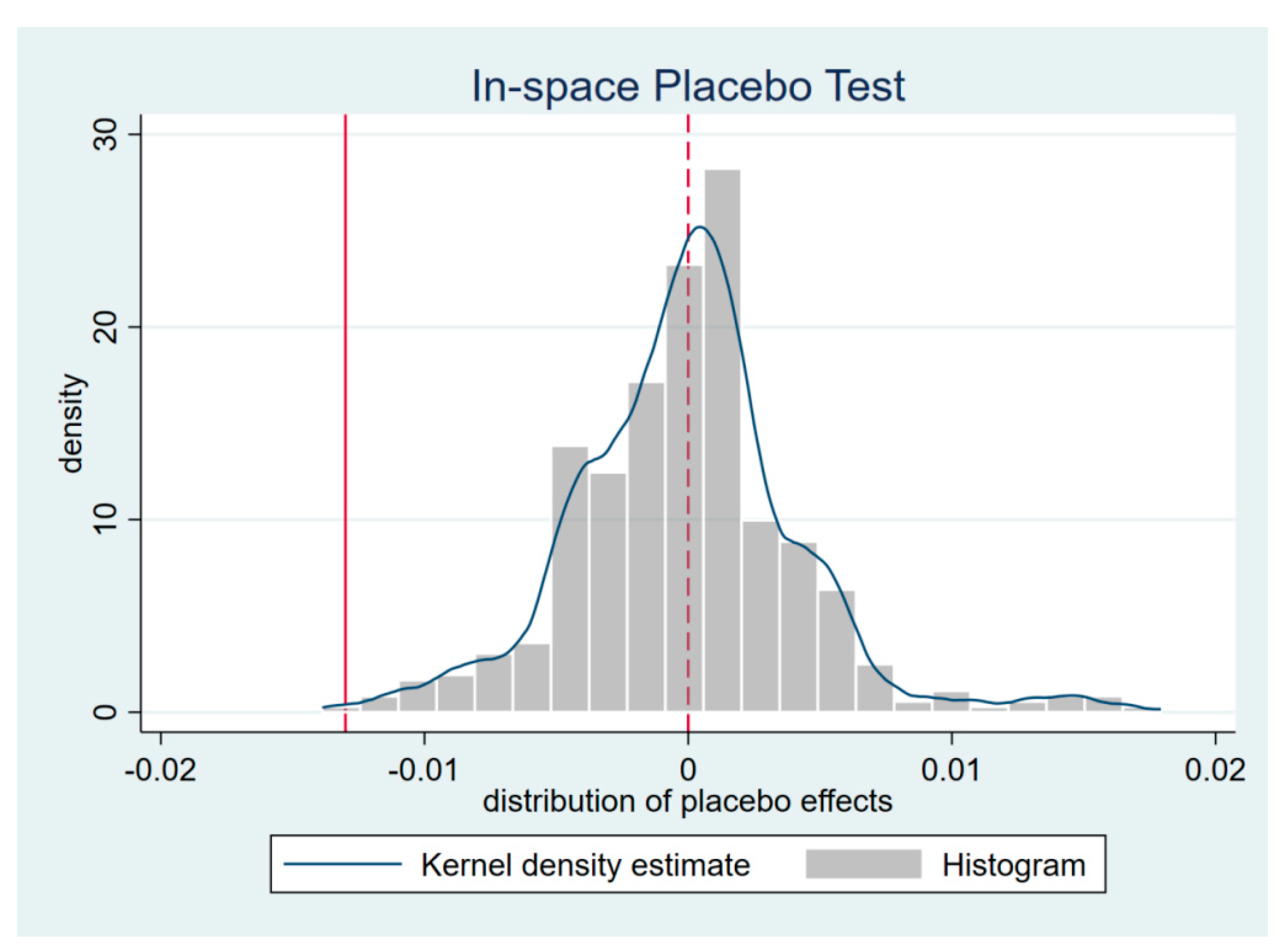1. Introduction
As the population continues to grow around the world, basic resources used in agriculture, such as land and water, are reaching their limits [
1]. Land degradation, decreasing arable land, and water shortages have placed immense pressure on the sustainability of agricultural production, according to reports by the UN Convention to Combat Desertification (Global Land Outlook 1st edition|UNCCD) and the Intergovernmental Panel on Climate Change (
https://www.ipcc.ch/srccl/, accessed on 25 March 2025) [
2]. Against this backdrop, governments worldwide must seriously consider ways to meet agricultural production demands while ensuring environmental protection. In agricultural production, excessive use of fertilizers, overuse of pesticides, and improper irrigation can lead to environmental pollution. The introduction of environmental regulations is an effective measure. Incorporating environmental regulations into agricultural production not only reduces the excessive use of chemical fertilizers and pesticides but can also enhance resource utilization efficiency. While environmental regulations promote agricultural sustainability, conserve fundamental resources, and protect ecosystems, they may also negatively impact agricultural production. In the short term, environmental regulation increases agricultural production costs [
3] and restricts certain agricultural activities, thereby affecting farmland productivity. Therefore, it is essential to explore ways to minimize the negative effects of environmental regulations on agricultural development while simultaneously promoting growth. Specifically, this objective can be achieved by examining the impact of environmental regulations on agricultural total factor productivity (ATFP). Since ATFP reflects the efficient utilization of resources in the agricultural sector, it also plays a crucial role in determining the long-term growth potential of agriculture [
4].
This balancing challenge is particularly complex in the case of China. As the world’s largest developing country and a major agricultural producer, China’s agriculture continues to be a key driver of economic development. With ongoing economic growth and agricultural modernization, effectively improving ATFP is not only essential for advancing China’s agricultural modernization but also has profound implications for strengthening the country’s overall economic competitiveness [
5]. As shown in
Figure 1, although China has the largest proportion of rural population globally, its per capita arable land and agricultural output remain relatively low compared to developed countries.
This reality underscores the immense pressure on Chinese agricultural producers to enhance production efficiency and compels policymakers to continuously explore effective policy solutions to address this challenge [
6]. According to World Bank data, more than 70% of China’s labor force is directly engaged in agricultural production, with agricultural development being driven by county-level and higher local governments, supported by local government policies and services [
7]. The role of prefecture-level cities in implementing agricultural policies has become increasingly significant. China’s agricultural development path and policies have gradually taken on distinctive national characteristics. These characteristics are reflected not only in its vast agricultural labor force, limited land resources, and regional economic disparities but also in its unique local governance structure and policy implementation mechanisms. For instance, the eastern coastal regions focus on high-tech agriculture and industrialization, whereas the western regions prioritize infrastructure development and improving farmers’ income levels. These unique circumstances have led to profound institutional transformations and policy adjustments in China’s agricultural sector. China has accumulated rich experience over time in developing agricultural production, raising farmers’ income, advancing agricultural modernization, and achieving sustainable development. The country’s agricultural policies have proven to be highly adaptable and widely applicable, making them effective across diverse regions and conditions. Therefore, by studying China’s agricultural development experience and policy outcomes, other developing countries can gain valuable insights into designing and implementing effective agricultural policies tailored to their own economic and social conditions. In doing so, they can better address agricultural production challenges, enhance ATFP, and foster sustainable agricultural development.
The effect of environmental regulations on ATFP remains uncertain. While the relationship between agricultural production and environmental protection has been widely debated, it is still unclear whether environmental regulations consistently have a positive impact on ATFP. Conventional perspectives often suggest that such regulations may raise agricultural production costs and even limit production efficiency [
8]. However, as research on the ecological environment and sustainable agricultural development continues to deepen, an important question emerges: Are there specific environmental regulations that can simultaneously safeguard the environment and enhance agricultural productivity? This question merits further investigation.
Relevant studies demonstrate that scientific applications of nitrogen and phosphorus can effectively curtail overreliance on chemical fertilizer applications to minimize their detrimental environmental impacts while maintaining agricultural production at present or even elevated levels [
9]. Traditional agricultural policies have generally been public or economically driven with shallow interdisciplinary depth and technical understanding. As key factors in plant growth, nitrogen and phosphorus’s bioavailability, transformation pathways, and interactions with microbial communities in soil have crucial functions to play in influencing sustainable agricultural development. Interdisciplinary knowledge can therefore more effectively address agricultural ecosystem complexity to provide more precise emission control indicators and more effective regulatory measures.
Recently, high-quality development has emerged as a central strategy being adopted by the government of China to propel economic development [
10]. In pursuit of this objective, a series of policies have been implemented to enhance industrial structures and enhance total factor productivity, including the pilot policy of controlling nitrogen and phosphorus emissions (PCNPE). The PCNPE is premised on the 2017 Classification Management Directory of Fixed Pollution Source Discharge Permits and considers historical environmental statistics on nitrogen and phosphorus emissions, industry-specific emission levels, and sizes of enterprises. Based on such details, fertilizer and pesticide production industries, centralized sewage treatment facilities, and large-scale breeding farms of pigs and poultry have been prioritized as key control targets by the government with regard to local government and enterprise responsibility in pollution control. The policy also mandates enterprises in key sectors to be equipped with automatic online monitoring systems for total nitrogen and/or total phosphorus indicators that are connected to environmental protection authorities to allow real-time monitoring and openness of information. In general, this policy aims to cut back on excessive nitrogen and phosphorus emissions through precise governance to reduce environmental pressures due to overuse of chemical fertilizer while ensuring agricultural production sustainability and stability. PCNPE is a step in the direction of more precise and realistic policy interventions in China’s agricultural sector.
Existing research primarily focuses on environmental regulation aimed at reducing undesirable outputs, such as wastewater, exhaust gases, and carbon dioxide emissions. However, there is relatively limited exploration of the effects of restricting the use of essential agricultural inputs such as nitrogen and phosphorus. As crucial elements for plant growth, the bioavailability, transformation processes, and interactions between nitrogen, phosphorus, and soil microbial communities are key factors constraining agricultural sustainability. Nevertheless, most prior studies have focused on heavily polluting industries like manufacturing and industrial sectors, leaving a significant empirical research gap regarding agriculture. Given that agriculture fundamentally differs from industry in terms of resource dependence, production patterns, and environmental requirements [
11], findings from industrial studies cannot be simply extrapolated to agriculture [
12]. More importantly, traditional agricultural policy studies often rely on single-disciplinary perspectives—such as pure economics or public policy—and lack interdisciplinary considerations of the biochemical and ecological characteristics of nitrogen and phosphorus. This leads to inadequacies in policy precision. Particularly at the prefecture level in China, how agricultural producers adjust their production strategies in response to PCNPE and the subsequent effects on ATFP remain underexplored. Therefore, this study innovatively investigates the impact of nitrogen and phosphorus restrictions on agricultural production from the perspective of input-oriented environmental regulation, filling an important research gap.
Specifically, this research seeks to explore how China’s agricultural sector can address the dual challenges of increasing production and reducing pollution and how an environmental regulatory framework can simultaneously achieve ecological protection and enhance ATFP. To this end, this study uses panel data from 164 prefecture-level cities across China (2003–2022) and employs a regression method combining the difference-in-differences (DID) approach with multidimensional fixed effects. It empirically evaluates the impact of PCNPE on ATFP and analyzes the comprehensive effects of PCNPE on resource allocation, production efficiency, and the ecological environment. The findings offer theoretical support and practical case references for the sustainable development of agriculture in China, providing policymakers with empirical evaluations to aid in more precise decision making and policy optimization.
The results indicate that, although PCNPE initially exerts a negative effect on ATFP, it promotes agricultural technological innovation over time. In line with the Porter hypothesis, the innovation driven by the policy can eventually reverse its initial inhibitory effects, resulting in a long-term enhancement of agricultural productivity.
The potential marginal contributions of this study are as follows: (1) Focusing on prefecture-level cities in China, this is the systematically evaluation of the specific implementation effect of PCNPE based on multidisciplinary knowledge in different regions and its mechanism of impact on ATFP. This bridges the gap in empirical research on agriculture that mostly only examines the knowledge of a single discipline. (2) It investigates how restrictions on key agricultural production inputs such as nitrogen and phosphorus affect agricultural production, revealing that, while phosphorus restriction has a significant impact on ATFP, nitrogen restriction does not—although both factors are theoretically important for crop growth.
The remainder of this paper is organized as follows:
Section 2 provides a literature review;
Section 3 describes the theoretical framework and hypotheses;
Section 4 outlines research design;
Section 5 provides empirical results;
Section 6 addresses heterogeneity analyses;
Section 7 explores the underlying mechanisms;
Section 8 is a comprehensive discussion and suggestions for policy optimization;
Section 9 presents the limitations and prospects of the research.
3. Theoretical Analysis and Hypotheses
Nitrogen and phosphorus are essential for crop growth. Most fertilizers contain significant amounts of these elements. After implementing pilot policies controlling nitrogen and phosphorus, fertilizer use is restricted, reducing soil-absorbable nitrogen and phosphorus and directly affecting crop yield and quality [
42]. Nitrogen is involved in crop metabolic cycles, and phosphorus is closely related to root development and energy conversion. Reasonable nitrogen and phosphorus control aims to optimize their use efficiency, prevent resource waste and environmental pollution from overuse, and ensure long-term agricultural sustainability and output [
43]. In the short term, such policies affect fertilizer input but also promote agricultural technological innovation. Many innovations, especially in efficient fertilizer use, now focus on improving nitrogen and phosphorus efficiency and reducing reliance on high nitrogen and phosphorus inputs to meet policy requirements and production needs [
44]. For example, precision agriculture technology precisely controls fertilizer application rates and timing, optimizes nitrogen and phosphorus supply, improves fertilizer efficiency, cuts waste and environmental pollution, and ensures crop growth. This shows that nitrogen and phosphorus control policies drive agricultural technological innovation, enhancing the sustainability and environmental friendliness of agricultural production.
Essentially, restricting fertilizer use promotes the adoption of these agricultural innovations, further advancing agricultural technological progress and production efficiency. To offset potential yield losses, producers must enhance soil productivity through organic matter introduction, management technology optimization, and agricultural machinery system investment [
25,
45,
46,
47]. These measures require extra labor, financial, and technical support, increasing production costs to maintain yields comparable to those with high fertilizer inputs [
48]. Under these circumstances, implementing nitrogen and phosphorus control measures can lower local agricultural TFP in the short term.
More importantly, nitrogen and phosphorus control policies may drive agricultural industrial structure adjustments. Producers may shift to crops with lower nitrogen and phosphorus dependency, which often have lower yields and total output [
49]. While this reduces environmental burdens, it also lowers overall agricultural production efficiency. In regions dominated by food crop production, the adjusted crop structure may fail to achieve the same output level as the original production model in the short term [
50]. Moreover, changing production methods entails greater total costs (e.g., adjusting crop growth environments and altering agricultural production factors), further hindering the improvement of agricultural TFP. A flowchart can be employed to illustrate the elements in the research mechanism and logically link them, thereby strengthening the rationale, as shown in
Figure 2.
Based on the above discussion, the following hypothesis is proposed:
Hypothesis 1. Short-term curtailment of ATFP increases will be achieved through imposition of policies to regulate nitrogen and phosphorus.
Environmental regulation exhibits a “U”-shaped effect on agricultural green transformation. As regulation intensity increases, agricultural green TFP is first suppressed and then promoted [
51]. As part of environmental regulation, PCNPE may follow a similar dynamic path. Initially, PCNPE increases costs and requires production method adjustments, suppressing production efficiency. However, once PCNPE reaches a certain intensity, governments may adopt agricultural technology subsidies and other support to compensate for profit losses and encourage technological innovation [
52]. As producers gradually adapt and utilize technological innovations, they enhance crop yield and quality [
53]. In the long run, nitrogen and phosphorus control drive agricultural technological innovation, promote green transformation, and force the reconfiguration of production factors, thereby optimizing the production factor structure needed for sustainable agricultural development [
26,
54].
Overall, PCNPE will prompt agricultural producers to shift to cleaner and more advanced modes of cultivation while optimizing agricultural input structure, ultimately increasing efficiency in utilizing resources and ATFP [
55]. In summary, this paper puts forward the following hypothesis:
Hypothesis 2. Implementation of PCNPE will stimulate agricultural technology innovation (ATI) that will ultimately offset the initial negative impact on ATFP and eventually lead to long-run gains.
4. Research Design and Data
4.1. Econometric Model Design
This study treats PCNPE as a quasi-natural experiment and uses the DID approach combined with regression analysis to evaluate its impact on the ATFP of Chinese prefecture-level cities. The goal is to explore how agricultural production adapts under nitrogen and phosphorus emission constraints, thus testing Hypothesis 1. PCNPE was implemented in some prefecture-level cities starting in 2016. When selecting research samples, and based on the parallel trend assumption, the actual implementation strength and policy participation of local governments were considered. Ultimately, 164 prefecture-level cities from 2016 were chosen as research samples. In these samples, cities implementing the phosphorus emission control policy (PCPE) and the nitrogen emission control policy (PCNE) were set as the experimental group, while other prefecture-level cities with complete variables served as the control group. We find the net effect of PCNPE on ATFP with an econometric model.
This study follows up on existing literature on the DID framework [
56] and leverages recent advances in econometric modeling to construct a DID regression model with two-way fixed effects. The exact econometric specifications are in Equations (1) and (2):
In the econometric model, represents the ATFP level of prefecture-level city i in year t. is the intercept term of the model. denotes the regression coefficient of the interaction term between the dummy variable for total nitrogen and total phosphorus control areas and the policy implementation dummy variable, which is used to estimate the causal effect of PCNPE on ATFP. Nc and pc are dummy variables for total nitrogen and total phosphorus control areas, respectively. If a prefecture-level city belongs to a total nitrogen or total phosphorus control area in a given year, the variable takes a value of 1; otherwise, it is 0. Post is a dummy variable measuring the policy implementation period, which takes a value of 1 for the years when the policy was implemented (2016 and beyond) and 0 otherwise. The vector represents the regression coefficients of control variables, capturing their impact on the dependent variable. The column vector includes control variables such as: Economic development level (Lnpgdp), financial efficiency (fe), government intervention level (gi), industrial structure (is), and rural labor force level (Lnrp). The term represents prefecture-level city fixed effects, which control for time-invariant characteristics of each city. denotes year fixed effects, which account for differences among prefecture-level cities caused by time factors. is the random error term.
To ensure the unbiasedness of the DID estimates, it is crucial to verify whether the treatment and control groups satisfy the parallel trends assumption before PCNPE implementation. If this assumption is violated, the econometric model may yield biased estimates of the policy effects. Specifically, this study employs an event study method to conduct the parallel trends test, with the corresponding test equation given in Equation (3). Additionally, 2015 (the year prior to policy implementation) is selected as the baseline period to avoid strict multicollinearity issues.
In the model, represents the coefficient of the interaction term between the k-period time dummy variable and the policy dummy variable, which is used to estimate the treatment effect for each period. is a treatment group dummy variable, indicating whether a prefecture-level city belongs to the experimental group for policy implementation. represents the k-period time dummy variable, (e.g., takes a value of 1 only in the year 2014, and 0 in all other years). The vector contains the regression coefficients of the control variables, while the meanings of the remaining symbols remain consistent with Equation (1).
Additionally, heterogeneity analysis is crucial for local policymaking, as different regions respond differently to policies. To explore the implementation of PCNPE across different regions and provide targeted improvements for existing policies, econometric models (Equations (4) and (5)) are established for further analysis.
In the model, represents the heterogeneity variable of prefecture-level city i in year t. The coefficient denotes the regression coefficient of the heterogeneity variable, while represents the regression coefficient of the interaction term between the core explanatory variable and the heterogeneity variable. The meanings of all other symbols remain consistent with Equations (1) and (2).
Finally, this study establishes Equations (6) and (7) to test Hypothesis 2.
The model, denotes the ATI level of the -th prefecture-level city in year , serving as a mechanism variable. The meanings of all other symbols are consistent with those in Equations (1) and (2).
4.2. Variable Selection and Construction
For ATFP measurement, we refer to recent literature [
57,
58,
59] and adopt the slack-based measure data envelopment analysis (SBM-DEA) model of Tone (2001) [
60]. The model does not rely on pre-specification of the production function but utilizes mathematical programming to calculate ATFP. In contrast to conventional methods, it does not rely on assumptions of functional form of the production function and therefore avoids functional form specification bias. The model also includes slack variables that allow full input and output slacks evaluation to avoid evaluation biases in conventional DEA methods that are constrained by radial and proportional changes. More importantly, comparative efficiency evaluation of decision-making units (DMUs) that operate on the frontier is facilitated by the SBM-DEA model. The mathematical specification of this model is shown in
Appendix A.
In this context,
represents the measured ATFP of prefecture-level cities,
denotes the number of input indicators, and
represents the number of expected output indicators.
and
denote the slack variables for the i-th input indicator, while
and
denote the slack variables for the r-th expected output indicator.
represents the observed value of the i-th input indicator at time t.
represents the observed value of the r-th expected output indicator at time t.
is the weight vector of the j-th decision-making unit at time t, and
indicates constant returns to scale. Furthermore,
and
represent the values of the
-th input and r-th expected output indicators for the
-th DMU at time
, respectively. The relevant input and output indicators are presented in
Table 1.
- 2.
Selection and Use of Core Explanatory Variables
The core explanatory variable is the interaction term between the policy dummy variable and the implementation time dummy variable. It is assigned a value of 1 if a prefecture-level city falls within a total nitrogen or phosphorus control zone in a given year; otherwise, it is 0. This interaction term measures the PCNPE policy implementation effect and is key to analyzing the policy’s impact on ATFP.
For PCNE, the experimental group comprises 22 prefecture-level cities with policy implementation and complete data, while the control group consists of 142 cities without policy implementation and complete data.
For PCPE, the experimental group includes 11 cities with policy implementation and complete data, while the control group comprises 153 cities without policy implementation and complete data.
Figure 3 visualizes the two pilots.
- 3.
Selection and Use of Mechanism Variables
Based on Hypotheses 1 and 2, and drawing on relevant literature, this study selects the number of agricultural invention patents as a proxy for ATI [
61,
62]. Data are sourced from China’s National Intellectual Property Administration. This choice has several advantages: First, agricultural invention patents cover a wide range of fields, including agricultural machinery, chemical fertilizer production, agricultural product processing, and agricultural information technology, comprehensively reflecting the scope and depth of agricultural innovation. In contrast, the agricultural mechanization rate only reflects the popularity of machinery use, not the breadth of technological development. Additionally, patents have clear legal status and public availability, making them highly accessible and comparable for collection and analysis. Unlike R&D investment data, which is difficult to obtain and standardize due to varying accounting practices, patents directly indicate technological innovation outcomes.
- 4.
Control Variables: Choice and Application
We address the problem of endogeneity in this research by including the following control variables: Level of economic development, level of government intervention, rural labor force population, financial efficiency, and industrial structure. According to Faluk Shair et al. (2021) [
63], economic development has a significant impact on production efficiency. Technological progress and optimal resource allocation enhance production efficiency and hence stimulate economic development. Therefore, to control for the likely impact of economic development on ATFP, this study employs the natural logarithm of per capita GDP as a control variable. This alleviates concern with regard to endogeneity such that regression coefficients more accurately reflect actual impacts. Additionally, Na Zhang et al. (2024) [
64] found that government intervention positively affects production efficiency. Government intervention through administrative and fiscal policies can maximize resource utilization and reduce agricultural operating costs. Additionally, government intervention helps to steer agriculture to environmentally friendly and sustainable production techniques that enhance production efficiency while conserving the environment. Therefore, the fiscal expenditure and GDP data of the general budget of each prefecture-level city in the current year are used to calculate the ratio of the two to control the possible impact of government intervention on ATFP. Lastly, Yongchun Sun (2022) [
65] emphasized that rural labor force size matters in ATI and ATFP. The organization and size of the rural labor force have a direct impact on agricultural production efficiency and output as well as on ATFP through technological substitution and human capital effects. As urbanization increases, agricultural labor moves to cities through rural-to-urban flows, resulting in labor shortages that force technological and mechanization progress in agriculture that enhances ATFP. Therefore, through statistical data such as the “Chinese Population and Employment Statistical Yearbook”, the rural population data of each prefecture-level city in the current year are obtained, and the natural logarithm is taken after adding 1 to control the impact of rural labor force size on ATFP. Above all else, Hu et al. (2021) [
66] noted that the financial system is important in allocating resources. An effective financial system can lower agricultural enterprises’ cost of finance and ease finance constraints and eventually impact ATFP. For capturing financial efficiency, based on statistical data such as the China Financial Statistical Yearbook, this study uses the loan-to-deposit ratio (LDR) in prefecture-level cities as an indicator of financial efficiency. The LDR is a direct indicator of financial institutions’ ability to convert savings to investment and hence is a primary indicator of financial system efficiency. The higher LDR implies a more efficient transfer of capital to demand sectors from surplus sectors. Financial efficiency is hence utilized as a control variable in the regression equation. Lastly, Chen et al. (2023) [
67] attested that industrial structure optimization not only increases technological progress and efficiency in allocating resources but also increases agricultural modernization through technology spillover effect and therefore increases ATFP. So, we introduce industrial structure as a control variable. Through statistical data such as the China City Statistical Yearbook, the added value of the primary industry and GDP data of each prefecture-level city in the current year are obtained, and the proportion of the added value of the primary industry in GDP is calculated to measure the industrial structure.
Lastly, by introducing such control variables, we effectively control over direct and indirect effects of economic development, government intervention, rural labor force size, financial efficiency, and industrial structure on ATFP. This alleviates concerns over endogeneity and ensures that the estimated coefficient of the core explanatory variable more precisely captures actual policy impacts. As such, reliability and accuracy of research findings improve and hence a more scientific basis exists to study factors influencing ATFP.
4.3. Sample Selection and Sources of Data
This study used panel data from 164 prefecture-level cities in China between 2003 and 2022, with cities with complete data as the control group to ensure the accuracy and reliability of the analysis and cities implementing PCNPE policies as the experimental group. The data include the following key economic and agricultural indicators: Per capita GDP, general government spending on government purchases, GDP, value added of the primary sector, and number of agricultural invention patents. These data are obtained from the China Regional Economic Statistical Database and the EPS Data Platform. The nitrogen and phosphorus control pilot program data are sourced from official Chinese government documents issued by the State Council, and dummy variables are manually constructed based on these policy documents. The LDR is derived from the China Prefecture-Level City Statistical Database available on the China Macroeconomic Data Platform. The rural permanent population data are collected from the Agricultural Statistical Yearbooks of various provinces and cities. To ensure data quality, we exclude prefecture-level cities with missing values for key variables. Moreover, to mitigate the impact of heteroskedasticity, we apply logarithmic transformations to non-ratio variables. The descriptive statistics and variable definitions after data processing are presented in
Table 2.
7. Mechanism Analysis
This section tests Hypothesis 2 that PCPE promotes ATFP in the long run by fostering ATI. The empirical results (shown in
Table 7) reveal that, when replacing the dependent variable with Lntpa and using stepwise regression (columns (1)–(6)), the core explanatory variable pcp has a significantly positive coefficient at the 1% significance level. This indicates that PCPE indeed promotes ATI, which subsequently enhances ATFP, thus supporting the “Porter hypothesis”. On average, PCPE can increase ATI by approximately 2.1%. Column (7) presents the PSM-DID regression results. Here, pcp remains significantly positive at the 5% level (t-value = 2.24), with a coefficient of 0.071. This finding confirms that PCPE continues to have a positive effect on ATI even after addressing potential endogeneity through PSM-DID. Overall, these results provide strong evidence supporting the conclusion that PCPE promotes ATI, thereby boosting ATFP over time. This empirical validation strengthens the credibility of the theoretical analysis. Existing literature [
91,
92,
93,
94] also identifies ATI as a crucial mechanism linking PCPE to ATFP. By improving agricultural technologies and management practices, optimizing resource allocation, and increasing crop yields and quality, ATI ultimately enhances ATFP. Thus, the mechanism analysis empirically confirms Hypothesis 2.
The promotion of ATI by PCPE is reflected in several specific policy measures: Government-funded agricultural research projects: Direct investment into research programs accelerates the development of new technologies. Increased R&D investment: Dedicated resources for innovation foster breakthroughs in agricultural production. Tax incentives: These reduce innovation costs for agricultural firms, encouraging technological upgrading. Technical training subsidies: These enhance farmers’ skills and accelerate the diffusion of new technologies. These measures collectively create a favorable innovation environment, promoting effective interaction among governments, research institutions, enterprises, and farmers and forming a strong innovation synergy.
ATI covers various technological domains: Biotechnology: Enhances crop resistance to pests and diseases, reduces pesticide use, and improves crop quality. Information technology: Enables precision agriculture through GPS, sensors, and data analytics, optimizing field management and boosting production efficiency. Engineering technology: Drives the automation and intelligent operation of agricultural machinery, enhancing operational efficiency and promoting large-scale, standardized farming. These technological innovations complement each other in driving improvements in agricultural productivity.
The impact of PCPE on ATFP exhibits a phased nature:
Short term (1–2 years after implementation) [
95,
96]: Baseline regression shows that PCP has a negative effect on ATFP because the time horizon of the study sample is not long enough, ATI needs time to work, and it has not accumulated enough returns to reverse the negative effects. Specifically, the introduction of new technologies needs to overcome the problem of farmers’ learning cost and technology adaptability, which may lead to a temporary decline in production efficiency. The high initial investment of ATI, such as equipment purchase, technical training, and infrastructure construction, is difficult to compensate for through increased output in the short term, which has a negative impact on ATFP [
57]. In addition, the imperfection of the technology promotion system may also lead to information asymmetry and technology misuse, which will exacerbate the short-term negative impact.
Medium term (3–5 years after implementation) [
97,
98]: Some of the ATI results invested in the early stage were gradually applied and promoted, and some farmers initially mastered the new technology, and the learning cost was reduced. The weak links of the technology promotion system have also been improved, the threshold for technology application has been lowered, and the negative impact of ATI on ATFP has gradually decreased, but the positive effect has not yet fully appeared.
Long term (over 5 years after implementation) [
99,
100]: The technology is mature, the promotion system is perfect, and the positive effect of ATI is gradually emerging and enhanced. The maturity of the technology is reflected in the improvement of performance, the reduction of costs, and the acceleration of technology diffusion. Agricultural R&D continues to advance, and new technologies continue to emerge and be adopted by more farmers, improving the overall efficiency of agricultural production and significantly positively impacting ATFP. The perfect extension system lowers the threshold for technology application, reduces the learning cost of farmers, accelerates the popularization of new technologies, and promotes continuous improvement and optimization of technologies. This long-term effect reflects ATI’s central role in sustainable agricultural development and its far-reaching impact on production efficiency [
101].
In summary, ATI enhances ATFP by: Optimizing production efficiency, improving resource allocation, introducing new production and management methods, reducing resource inputs per unit of output, and enhancing the efficiency of labor, capital, land, and natural resources. Technological progress streamlines production processes and enables more effective resource utilization, ultimately driving sustained improvements in agricultural TFP [
102,
103].
Thus, although PCPE may have short-term negative effects, it promotes long-term productivity gains by fostering agricultural technological innovation.
8. Conclusions and Recommendations
8.1. Conclusions
Since China is facing the challenge of reconciling agricultural production expansion with environmental sustainability, it is crucial to design environmental regulations that both maintain the ecosystem and enhance ATFP. In response to this challenge, this study constructs a quasi-natural experiment setting and employs panel data spanning 164 prefecture-level cities in China between 2003 and 2022. The impact of PCNPE implementation on ATFP and its mechanism is analyzed using DID augmented with regression analysis. The results indicate that, in the short run, after controlling other determinants of ATFP, PCPE reduces ATFP by approximately 0.013 units on average while PCNE does not have a statistically significant impact on ATFP. This suggests that agricultural production is dependent to a larger extent on phosphorus than nitrogen. In addition, restricting phosphorus application in the short run suppresses ATFP. After subjecting findings to robustness tests including parallel trend tests, PSM-DID, and placebo tests, the conclusions remain valid. The heterogeneity analysis shows that, in contrast to non-key environmental protection areas, the adverse effect of PCPE on ATFP is smaller in key environmental protection areas. This suggests that accumulating environmental technologies can minimize environmental regulation policies’ adverse effect on ATFP. In addition, PCPE’s effect is smaller in suppressing ATFP in the central and eastern regions relative to the western region, indicating that these regions are more resistant to environmental regulations. More notably, even with variations in climate and crops between northern and southern China, PCPE’s effect on ATFP does not differ substantially between the two regions. Finally, according to Porter’s hypothesis, this study establishes that PCPE enhances ATFP in the long run by developing ATI. Briefly, this research provides new empirical evidence of Porter’s hypothesis in agriculture and presents biological and chemical information that can be used to inform policymakers who desire to balance agricultural production with environmental conservation.
8.2. Policy Recommendations
First, although the implementation of PCPE results in a short-term decline in ATFP, it can promote ATI and enhance ATFP in the long run. Thus, policymakers should focus on refining PCPE measures and expanding pilot programs to achieve the dual goals of environmental protection and high-quality agricultural development. Drawing on international experience, such as the European Union’s Horizon Program, the Chinese government could: Increase support for green agricultural technology R&D, establish special funds for technologies that replace phosphate fertilizers and restore soil health, and set up ATI centers to accelerate the mastery and application of new technologies by producers.
Second, considering regional differences in response to PCPE, policies should be tailored to local conditions: In key ecological protection areas, “technology–policy synergy” pilots could leverage existing environmental technologies to better balance ecological and production goals. In non-key areas, innovation subsidies should prioritize environmental technologies to promote cleaner production. In the central and eastern regions, continued investment in ATI is needed to enhance resilience to regulatory shocks. In the western region, efforts should focus on improving phosphorus fertilizer efficiency through infrastructure enhancement and farmer training. Additionally, the government should encourage technical cooperation between eastern and western regions to promote agricultural modernization across the country. For areas facing short-term productivity losses, governments can refer to policies such as the “Conservation Reserve Program” in the United States (
https://www.farmers.gov/sites/default/files/2022-05/farmersgov-conservation-programs-brochure-05-2-2022.pdf, accessed on 25 March 2025.). By providing financial compensation, technical assistance and financial support, we will help local agricultural producers tide over the difficulties and mitigate the negative impacts in the early stages of policy implementation.
Finally, to strengthen support for agricultural innovation, besides financial support, intellectual property protection should be enhanced to encourage participation from enterprises, research institutions, and individuals. A robust technology promotion system should be established through technical training, field demonstrations, and farmer field schools, accelerating the adoption of new technologies and maximizing their impact. These measures can effectively boost ATFP and achieve a win–win outcome of high-quality agricultural development and environmental sustainability.
